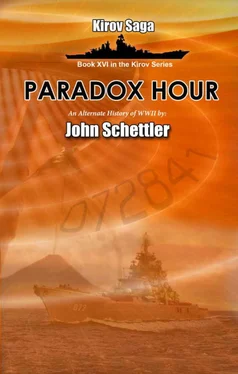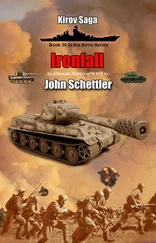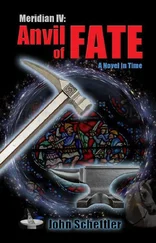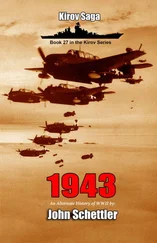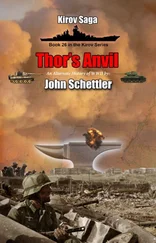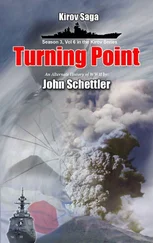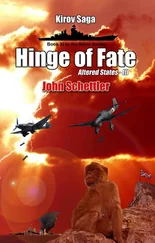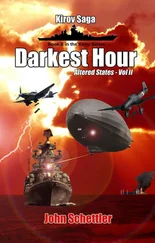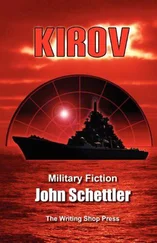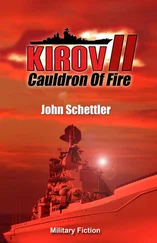There was just enough silence on the line for Karpov to realize he had drawn a little blood with that. He let Volkov stew a moment, then pressed on. “As for that little offensive you kicked off on the Ob, you and I both know that will lead you nowhere. Face it, Volkov. It’s 750 kilometers to your lines back west. You’ll never take Ilanskiy militarily— never . I’ll put three divisions here if I have to, and then you can bring every airship you have left, but they still won’t be enough to land anything more than a single brigade. And while you blunder about on the Ob, I’ve been making other plans.”
“Ha!” There was a challenge in Volkov’s tone now. “Where have you been, Karpov? Yes, you were hiding in that storm up there, but have you listened to the news lately? The Germans are about to cross the frontier into Sergei Kirov’s Soviet Union, or what’s left of it. It’s only a matter of time now. We’ve just been playing with you out here with a couple infantry corps, but now I’m mobilizing my entire army on the Volga. In two months time I’ll raise divisions from Kazakhstan to Turkmenistan, and raise a good deal of hell with them. This business on the Ob isn’t finished either. Once we shake hands with German troops on the Volga, and kick Kirov out of the Caucasus for good, then we come for you , Karpov.”
“Tough talk,” said Karpov. “You say you’ve archived your service jacket data files? Well why don’t you read a few. Germany lost this damn war. Have you forgotten that?”
“Not this time,” Volkov came back sharply. “No, not this time. It took every man that I can raise, and all your troops thrown in with Kirov to beat the Germans. You bet on the wrong horse, Karpov, and I’m going to enjoy these next few years as you struggle to raise troops out here. I had a good look at those Siberian Tartars you’re always crowing about. My men brushed them aside easily enough on the road to Kansk. The rest of your lot will get the same treatment.”
Time for the coup de grace , thought Karpov. Should I tell Volkov where I’ve been in recent days? Should I tell him I had a man staring at him from the upper window of the second floor at Ilanskiy, just hours ago? Hours, minutes, long decades. They were all the same now for Karpov. No matter what Volkov blustered about, the fact remained that he had lost this battle, and I still control Ilanskiy. That was going to make all the difference, and he decided to remind Volkov of that one important fact.
“Look here, Mister General Secretary. That was a nifty little trick you pulled with that escape pod, and yes, it looks as though you will make good your escape here as well. You and I both know I’m not giving up four thousand meters in elevation to settle this now, as much as I would love to see you leaping from another burning airship. Was the ride down comfortable last time? So, you can run your mouth all you want about the Germans. You think you can push all the right pawns, and king yourself on the back row before this game ends. But don’t forget me , Volkov. I’ll be sitting on the other side of the board now, right at Sergei Kirov’s shoulder. I know the history as well as you do.”
“Then let the game begin,” came the challenge. “Pawn to King four! You can castle to King side or Queen side. It won’t matter. The Germans will get through, in the south. They drove all the way to the Terek River, and that was with no help from me! So they’ll get through, and there’s nothing you’ll be able to do about it.”
“You’re forgetting one thing,” Karpov came back. “You’re forgetting the very reason you tried to pull this little maneuver here again—Ilanskiy. I beat you here, Volkov, and decisively, no matter how many airships we traded. I control Ilanskiy, and that’s the end of it. Do you realize what I can do when I complete the reconstruction of that back stairway? Yes, I’ve got all the original plans now.” He let an interval of silence play on the airwaves before he finished, then spoke only one word. “Checkmate!”
No response came back for some time, and there was static on the line from the storm. Then he heard Volkov’s voice again, a distant crackle on the speaker.
“See you in hell, Karpov. I’ll see you in hell.”
“I suppose you will,” said Karpov. “Yes, I’ll be sitting on Lucifer’s throne down there one day, so please come and pay your respects. Karpov out.”
He switched off the radio set, folding his arms and smiling. Let Volkov think long and hard about Ilanskiy. Let him wonder just what I might do when that stairway is complete again. He hasn’t the foggiest idea where I was these last few weeks and days, what I can do now with this ship, where I can go when I have need. I am no longer a simple fleet Admiral here. I’m not merely Kolchak’s lieutenant and Minister of all Western Siberia. No. I am so very much more now. I’m the master of time itself, and I can count the hours, minutes and seconds Volkov may have to live at my leisure. I can figure a way to put an end to that man, and a way to do the job myself instead of sending Tyrenkov. So let him raise his army here, while I raise mine.
For now, it was time to get back to the bridge.
“Nor does the man sitting by the hearth beneath his roof better escape his fated doom.”
―Aeschylus
Schlachtkreuzer Kaiser Wilhelm was a beautiful ship, fast and deadly as it plowed ahead through light swells that day. Laid down in 1937 by Deutsch Werke at Kiel, it was a design that evolved from the fast Panzerschiff models planned as successors to the Deutschland class pocket battleships. The Germans wanted a faster ship with 11-inch guns to better the performance of the Deutschland Class, but to get that speed required a longer hull and widened beam. This required more armor to cover that hull, which in turn added weight, and a vicious circle ensued. Thus only two of twelve planned Panzerschiff Kreuzers had been built, the Rhineland and Westfalen , and designers moved to a larger ship that could accommodate the armor and also get a dual propulsion system with both diesel engines for efficient long haul cruising, and turbines for high speed engagements.
The result was the Kaiser Wilhelm. At 35,400 tons, it was over 10,000 tons heavier than the Panzershiff, and with better armor and guns. Yet the designers had labored to give the ship the best speed possible, with four high-pressure Wagner boilers, which had a distinctive sound when they were fully fired for high speed performance. The engineers had come to call them “Wagner’s Girls” when they were singing, and Chief Engineer, Otto Kremel, was fond of putting on a recording of the famous composer’s Ride of the Valkyries when the ship ran at high speed. Designed to achieve over 33 knots, the ship had demonstrated the ability to run at 36 knots in trials, an amazing feat for a ship with a displacement equal to British battleships of the Revenge Class, which labored to achieve top speeds of 21 to 23 knots.
Kaiser was all of 840 feet long to achieve that speed, a third longer than Revenge and with a wider beam as well. Yet that gain in speed had come at the expense of both armor and firepower. While the old Revenge Class had eight 15-inch guns, Kaiser had six, and while Revenge had heavy 330mm belt armor, the protection on Kaiser maxed out at only 190mm. This had led some designers to christen the ship Ohne Panzer Quatsch, disparaging its lack of armor.
As a battlecruiser design, the ship was more comparable to the British Renown Class, where it could match or better that ship in almost every category. Kapitan Werner Heinrich had been given command, and he was well schooled in cruiser operations, having served under August Thiele aboard the heavy cruiser Lutzow before this posh assignment. Now he was set on putting the whispered comments about his ship to rest. As he stood on the bridge that day, he was proud to be the vanguard of the fleet flagship, Hindenburg , and when the order came to close on the enemy contact and engage, his blood was up.
Читать дальше
